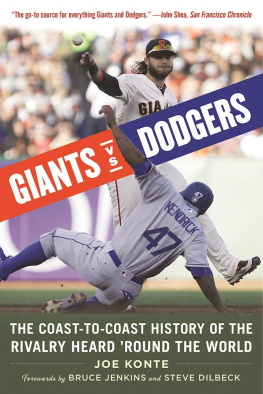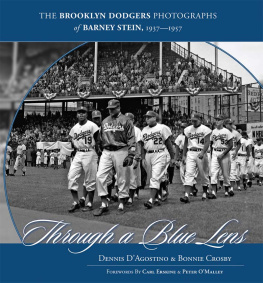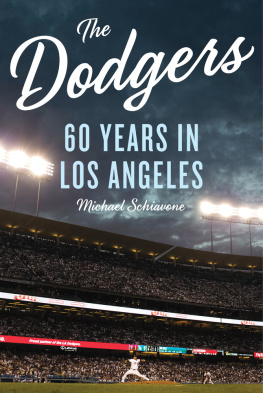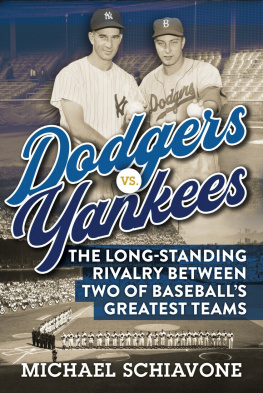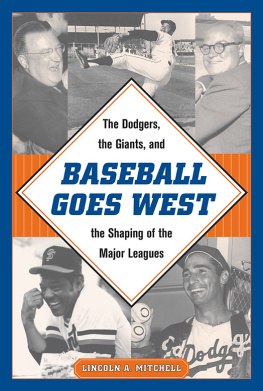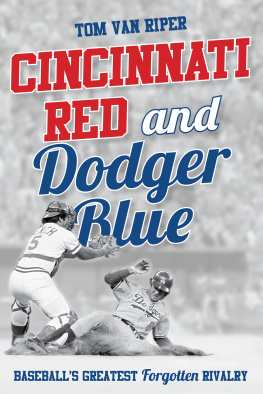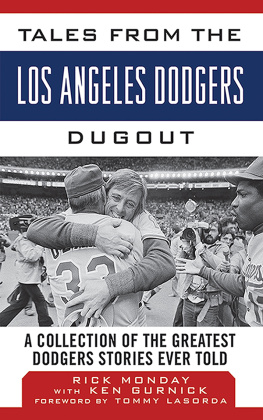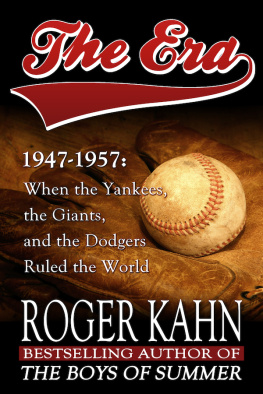COVER PHOTOS
Front: Giants shortstop Brandon Crawford throws over the Dodgers Howie Kendrick to complete a double play in the fifth inning June 12, 2016, at AT&T Park in San Francisco. Photo credit: Associated Press/Ben Margot
Back: Giants pitcher Madison Bumgarner and the Dodgers Yasiel Puig stare each other down as first base coach Bill Hayes stands between them after Puig was thrown out at first base September 19, 2016, in Los Angeles. The Bumgarner-Puig feud has heated up the rivalry on several occasions. Photo credit: Associated Press/Mark J. Terrill
Copyright 2013, 2017 by Joe Konte
All rights reserved. No part of this book may be reproduced in any manner without the express written consent of the publisher, except in the case of brief excerpts in critical reviews or articles. All inquiries should be addressed to Sports Publishing, 307 West 36th Street, 11th Floor, New York, NY 10018.
Sports Publishing books may be purchased in bulk at special discounts for sales promotion, corporate gifts, fund-raising, or educational purposes. Special editions can also be created to specifications. For details, contact the Special Sales Department, Sports Publishing, 307 West 36th Street, 11th Floor, New York, NY 10018 or sportspubbooks.
Sports Publishing is a registered trademark of Skyhorse Publishing, Inc., a Delaware corporation.
Visit our website at www.skyhorsepublishing.com.
10 9 8 7 6 5 4 3 2 1
Library of Congress Cataloging-in-Publication Data is available on file.
Cover design by Tom Lau
Print ISBN: 978-1-68358-044-7
Ebook ISBN: 978-1-68358-045-4
Printed in the United States of America
For my Dad,
who taught me how
to draw a throw
and other baseball strategy
CONTENTS
FOREWORD: DATELINE, SAN FRANCISCO
T he Dodgers-Giants rivalry changed my life at a very impressionable age. Its the reason I became a sportswriter, a delightful job that makes you question whether youre really working. And its still the highlight of a baseball summer, always making me feel like a little kid again.
Other than that, I dont have much to say about it.
I was 10 years old, living on the very northern edge of Los Angeles County, when the Dodgers and Giants moved West in 1958. My parents were top-flight musicians who spent so much time working in New York; we actually lived there for a couple of one-year spells when I was still traveling about by stroller. My dad had seen many games at Ebbets Field and the Polo Grounds, and a love of baseball was in his blood. I didnt inherit those musical genes, but sports gave us something to shareeven if it meant witnessing ballgames at a comically inappropriate venue.
Memorial Coliseum was all about the Rams, USC and UCLA football, and the wondrous deeds of track and field. No one in his right mind would try to fit a baseball configuration into that place, but it was the Dodgers only option before the unveiling of Dodger Stadium in 1962. The left-field line stopped cold at 250 feet (no choice; football seats there), so they erected a 42-foot screen to preserve the pitchers sanity. I dont recall the exact distance to right-center, but it was roughly the next town. It seemed like 480 feet, and it probably felt even farther to a powerful left-handed hitter like Willie McCovey.
I loved the Coliseum, truth be told. What did I know? Id never seen Ebbets or Wrigley or Fenway; this was my baseball palace. Ill never forget emerging from one of those long tunnels and into the sunlight, a gorgeous ball field before my eyes. It was 1958, the Giants were in town, and that would be my first exposure to the major leagues.
I cant remember the details, but I remember Willie Mays, Orlando Cepeda, Willie Kirkland, and Jimmy Davenport. The Dodgers badly needed to make an impression on Southern California, and wisely, they employed a number of great Brooklyn names, the likes of Gil Hodges, Duke Snider, and Carl Furillo, each near the end of a distinguished career. For history-minded kids like me, this was a crucial connection to the Dodgers past, a window into their long and colorful history.
As I grew older, I began to resent the Dodgers move from Brooklyn, at least on a peripheral level. I found it heartbreaking that theyd abandon their neighborhood ballpark and a passionate fan base that lived and died with the team. I got over that, of course. By 1959, the Dodgers were world champions and launching the golden era of Sandy Koufax, Don Drysdale, Maury Wills, and the Davis boys.
Many people recall Koufaxs 1963 no-hitter as his masterpiece against the Giants, but for me, it came on August 31, 1959, at the crazy old Coliseum. Those Giants were so loaded, they had McCovey batting second, followed by Mays, Cepeda, and Felipe Alouand Koufax struck out 18. This was a life-changing performance at the time, matching Bob Fellers record set in 1938and the fact that it came against the Giants made it that much sweeter. Wally Moon was famous for his Moon shotsa left-handed hitter going the opposite way to clear that screenand old No. 9 (the number I always sought in Little League) hit a three-run shot that night.
My perspective on life changed in the fall of 1966, when I left Southern California to attend UC Berkeley, and that included my relationship with the Dodgers. Suddenly, I was in Mays-and-McCovey country. The Dodgers lost that World Series in baffling fashion to the Baltimore Oriolesthe end of a fabulous era, as it turned out. I began to take a hard look at sportswriting, and by 1972, as a young writer for the Santa Monica Evening Outlook , I learned that a certain detachment is required for covering sports properly. But the Dodgers werent quite through changing my life. With the Outlooks beat writer taking a break, I was sent on a road trip through Chicago, St. Louis, and Pittsburgh to cover the Dodgers. Thats when I knew, beyond question, how I wanted my life to unfold.
So many Dodgers-Giants moments come to mind over the span of my 40-year San Francisco Chronicle career: Joe Morgans shot off Terry Forster, the emergence of Bobby Bonds, John Montefuscos swagger, titanic home runs from Mike Ivie and Brian Johnson, the fateful decision to pitch Salomon Torres, Tommy Lasordas flamboyant walks toward the Candlestick dugout, Barry Bondss epic at-bat against Eric Gagne, or just the simple pleasure of Jon Miller imitating Jon Ramseythe legendary Dodger Stadium PA announceror doing a Vin Scully impression in Japanese (who even thinks of that?). One night, after a particularly discouraging loss to the Dodgers, the Giants broadcasters assembled for their nightly wrap-up and picked their player of the game. Mike Krukow, particularly disgusted, picked a Giant who hadnt even played that nightanyone but a Dodger.
Id try to recall all of the great moments, but why bother? Thats the beauty of this book. In meticulous fashion, starting with the first official game between the franchises in 1889 and focusing intensely on the West Coast era, Joe Konte brings them all home. We owe him a debt of gratitude for his toil, surely a labor of love, and a work to be cherished by everyone who loves this little kids game.
Bruce Jenkins has written for the San Francisco Chronicle since 1973 and has been a sports columnist since 1989. He has covered 25 World Series.
FOREWORD: DATELINE, LOS ANGELES
M y parents were extremely proper. They raised me to try to avoid using the word hate, to understand the nastiness and near vulgarity of the remark. So believe me, I understand exactly what Im doing when I write:

